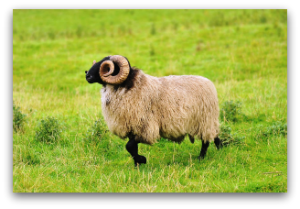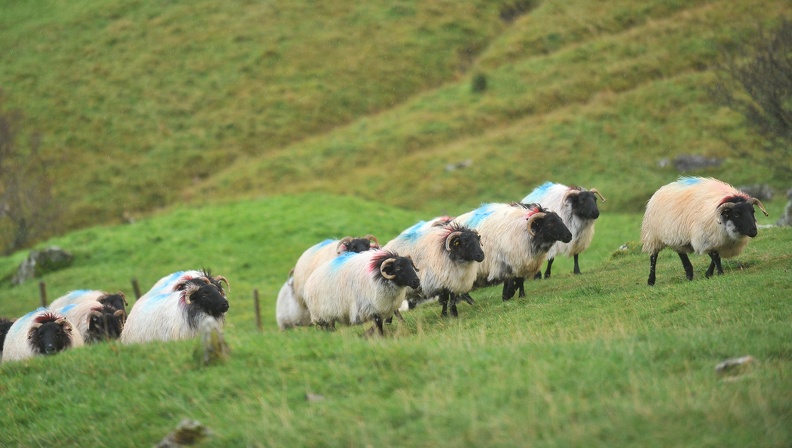Options for Finishing Hill Lambs
Michael G Diskin, Noel Claffey & Frank Hynes,
Teagasc, Mellows Campus, Athenry, Co. Galway.

The Scottish Blackface breed accounts for approximately 22% of the 2.5 million ewes in Ireland. The majority of these Blackface sheep are maintained on hills or marginal land that is not suited to other sheep breeds or other farm enterprises. Profits from these hill sheep enterprises is very much dependant on prices obtained for lambs sold. A large proportion of these lambs become available for sale annually from August onwards. In recent years, prices for hill lambs and in particular light hill lambs have been disappointing. This paper briefly examines different options to improve the marketability and profitability. The main focus of this paper is on pure Scottish Blackface lambs with some minor references to crosses of the breed.
Market
Traditionally, Ireland has been relying on the Mediterranean markets including Portugal, Spain and Italy to take the lambs from the hill flocks. In the past these markets required carcases from 10kg and upwards, with preferences for carcases from 12 to 15kg. While hill lambs meet these weight requirements, demands from these markets have declined in recent years. There has been a 54% decline in the level of exports to the three Mediterranean countries, and an 87% decline in the combined Portuguese and Spanish markets.
Hill lamb performance
There is much evidence that the performance of pure Scottish Blackface lambs in terms of liveweight gain, feed intake and feed conversion efficiency is lower than that of lowland lambs or from hill lambs crossed with lowland breeds. However, general performance trends are similar with both lowland and hill lambs. Many hill lambs are sold to lowland finishers and reappear in the spring as hoggets
Performance at grass
Post weaning performance at grass very much depends on quantity and quality of grass available. Results from Teagasc studies would suggest that well grown weaned hill lambs on well managed pasture can achieve approximately 115 g/ day or 0.8 kg /week in early autumn, (August / early September) while in late autumn, (Sept /October) this performance drops to 0.4 kg / week. Growth rate of lambs on hill pastures will be 50% below these levels. Furthermore, if the weaned lambs are very light, less than 25 kg, at this time of year performance will be depressed further.
Options for dealing with hill lambs
A number of options are discussed in terms of their advantages, disadvantages and expected lamb performance
Option 1: Sell at weaning
Advantages:
• Extra grass made available for ewe lambs and breeding ewes.
• Savings on flock health costs
• Improved cash flow
Disadvantages
• Poor prices for light lambs
• Limited markets.
• Lamb potential not exploited by primary producer
Option 2: Graze and sell at end of October
Requires excellent quality grass and grassland management
Advantages
• Heavier lambs
• Greater sale options
• Possibly higher prices
Disadvantages
• Less grass for ewe lambs and breeding ewes.
• Additional flock health costs
• Cash flow?
Expected Lamb performance
August – Mid-Sept: 115g/day or 0.8kg/week
Mid-Sept –End of Oct: 60g/day or 0.4 kg/week
Total liveweight gain: After 12 weeks = 7.2 kg
Option 3: Graze + Supplementary meal feeding at pasture and sell end of October
Requires excellent quality grass and grassland management + meal feeding (300g/lamb/day) by trough
Advantages
• Heavier lambs
• Greater sale options
• Possibly higher prices
Disadvantages
• Less grass for ewe lambs and breeding ewes.
• Additional flock health costs
• Cost of concentrates (€6.30/lamb)
• Cash flow?
Expected Lamb performance
August – Mid-Sept: 155g/day or 1.1 kg/week
Mid-Sept –End of Oct: 100g/day or 0.7 kg/week
6-9kg concentrates required for 1 kg liveweight gain.
Total gain after 12 weeks = 11kg.
The direct cost of the meal consumed per lamb will vary from €6.30 per lamb (€250/ tonne) to €8.82 (€350/ tonne). The key question is will the market at the end of October pay or the additional 4 kg of liveweight.
Option 4: Finish lambs on all-meal diet after weaning
This requires housing the lambs and finishing them on an-all meal diet.
Advantages
• Extra grass for ewe lambs and breeding ewes.
• Heavier lambs
• French lamb prices
Disadvantages
• Cost of meal
• Large quantity of meal required
• A long finishing period for light lambs
• Additional flock health costs
• Facilities
• Cash flow?
Expected Lamb performance
Average daily gain: 200g/lamb/day
Feed Conversion efficiency: 6.5-7kg Meal: 1 kg liveweight gain.
Market suitability: 90+% of the lambs should reach French market specification.
The profitability of this is very dependent on the following factors:
• The market price or valuation for lambs at weaning.
• Meal prices. These can be variable depending on location, quantities, ration composition and whether it can be purchased in bulk or bags. A high quality balanced ration suitable for feeding to finishing male lambs must be used.
• Lamb mortality: Ideally this must be kept below 4 %. Starting off with healthy lambs followed with good husbandry is essential.
• Sale price of finished lamb. Starting the intensive feeding of lambs in August –September will result in a high proportion of lambs being finished in November-December probably before there is a worthwhile increase in factory lamb prices.
Option 5. Graze for a period followed by finishing on all-meal diet
With this option the lambs are grazed until end of October or even longer when kept at a low stocking rate . During this period lambs would be expected to gain on average about 7-10 kg if grazed on very good quality grass. At the end of grazing period lambs would be housed and finished on an all meal diet. This is in fact the system that is followed by many lowland farmers. Store hill lambs are purchased in the autumn and grazed on grass until December.
Advantages
• Heavier lambs at start of meal feeding period
• Reduced meal requirement
• French lamb prices
• Higher prices in January-March.
• Reduced finishing period
Disadvantages
• Less grass for ewe lambs and Breeding Flock.
• Additional flock health costs
• Facilities
• Cash flow?
Expected Lamb performance
Grazing: 12 weeks grazing = 7.2 kg liveweight gain.
Indoors: Average performance =200g/day.
Feed Conversion Efficiency: 6.5-7kg of meal: 1 kg of liveweight gain
Market suitability: 90+% of the lambs should reach French market specification.
The finishing of lambs is very dependent on the following discussed under Option 4. With this option cheaper liveweight gain is achieved from grazed grass and the quantities of meal required are less. By starting the finishing period later there is a greater probability lambs ben sold in Jan when hogget prices usually
Performance of Hill and Crossbred lambs at Athenry 2013-2014
The performance of Hill and Crossbred lambs at Athenry 2013-2014 is summarised in Table 1. Lambs were kept indoors for the duration of the feeding period and fed a ration comprised of 70% cereals; 15% protein and a UFL of 1.00. Total lamb mortality was 3%


